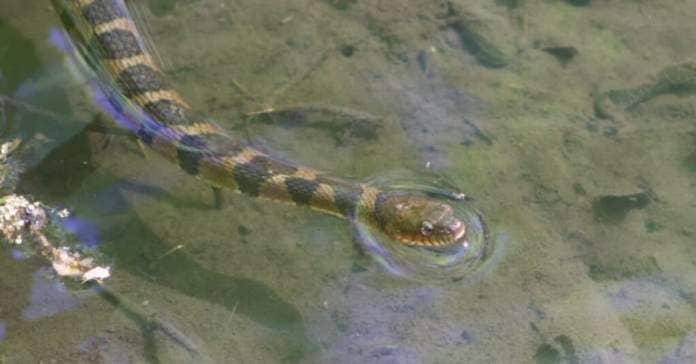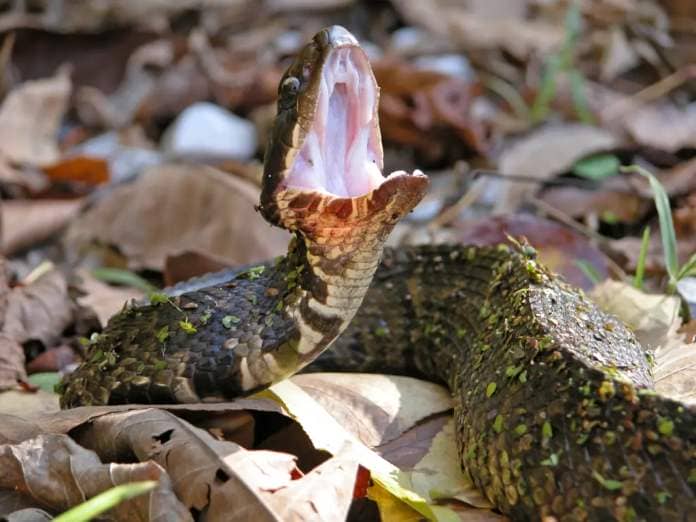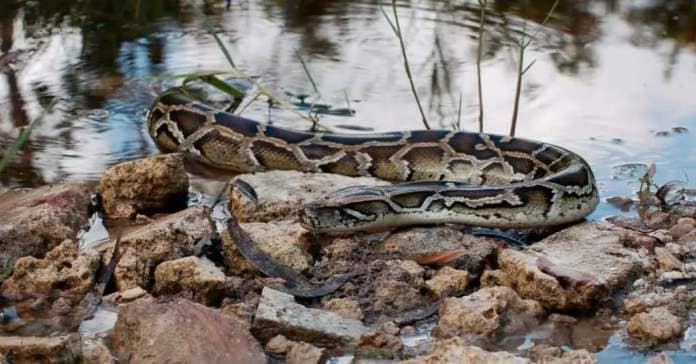Also known as Florida’s Inland Sea, Lake Okeechobee ranks as the largest inland lake in Florida. This giant freshwater lake also earns the tenth spot on the list of the 10 largest natural freshwater lakes in the United States. Lake Okeechobee supports a diverse ecosystem of plants and animals. Over 40 different fish species call the lake home, including crappie, bluegills, and largemouth bass. You can also find numerous snakes in Lake Okeechobee. Given its serpentine residents, is it safe to swim in the lake? Keep reading to find out!
Snakes in Lake Okeechobee
Lake Okeechobee encompasses nearly 730 square miles in southeastern Florida. Despite its massive size, the lake measures relatively shallow, with an average depth of just 9 feet in most spots.
In and around Lake Okeechobee, you can find various water and wading birds, fish, amphibians, reptiles, and mammals. The lake’s diverse wildlife makes it a prime habitat for many of the snakes found in Florida. South Florida is home to 34 of the 46 snake species native to the state as well as 3 non-native species. That said, there are a few species that you are most likely to encounter on the lake.
Here are a few of the snakes in Lake Okeechobee:
5. Brown Water Snake

©iStock.com/passion4nature
The brown water snake (Nerodia taxispilota) is a nonvenomous water snake in the family Colubridae. It also goes by the water-pilot, false moccasin, great water snake, water rattle, and southern water snake. A native of the southeastern United States, the brown water snake mostly inhabits flowing bodies of water, such as rivers, streams, and canals. However, you can also find them in reservoirs and lakes, including Lake Okeechobee.
Brown water snakes possess thick bodies that measure between 30 and 60 inches long on average. That said, especially large specimens can grow up to 69 inches long. Females typically measure larger than males. The dorsal side looks reddish-brown and sports around 25 dark or black square-shaped markings from the head to the tail. Meanwhile, the belly appears mostly yellow but also features black or dark markings. The brown water snake’s head measures noticeably larger and wide than its comparatively thin neck. People sometimes mistake it for a water moccasin, hence the name “false moccasin.”
Brown water snakes are excellent swimmers and eat a mostly pescatarian diet. They hunt either by actively hunting or ambushing their prey. When not swimming, they may rest on aquatic vegetation or tree branches hanging above the water. While not venomous, they can inflict a painful bite when threatened.
4. Banded Water Snake

©iStock.com/Dalene Capps
The banded water snake (Nerodia fasciata) also goes by the name the southern water snake. A member of the family Colubridae, the banded water snake lives throughout the southeastern United States. Its preferred habitats include lakes, ponds, marshes, and streams. You’re most likely to encounter them nestled within vegetation near the shoreline of Lake Okeechobee or in shallow zones throughout the lake.
Adult banded water snakes normally measure between 24 and 42 inches long. At maximum size, they can measure just over 62 inches long. In terms of weight, the average specimen weighs a little over a pound. Banded water snakes typically appear greenish-gray or brown and feature thick dark bands along the dorsal side, hence their name. The ventral side appears whitish. They sport a distinctive dark stripe that runs from the corner of each eye to the jawline. They possess long, flat heads and relatively heavy bodies.
Banded water snakes primarily feed on frogs and fish, although they may also prey on turtles, birds, crayfish, and other snakes. When threatened, they emit a foul-smelling musk from their anal glands. They can bite multiple times and will slash their bodies sideways to help them rend flesh from their target. While painful, their bite is not venomous.
3. Florida Green Water Snake

©iStock.com/passion4nature
The Florida green water snake (Nerodia floridana) is a species of water snake endemic to the southeastern United States. Experts originally classified it as a subspecies of green water snake (Nerodia cyclopion) before eventually identifying it as its own species. You can normally find Florida green water snakes in wetlands, swamps, marshes, and lakes.
The Florida green water snake ranks among the largest water snakes in North America. On average, specimens measure between 30 and 55 inches long. However, the longest Florida green water snake measured an incredible 74 inches long. In terms of color, the dorsal side looks mostly green with shades of gray or brown, hence its name. Meanwhile, the belly appears white or yellow. Florida green water snakes feature a characteristic line of scales below the eyes that stand separate from the upper lip scales.
Florida green water snakes are fairly active in Lake Okeechobee year-round. While particulars of the diet remain a mystery, most experts agree that they feed primarily on fish, frogs, and salamanders. Like other water snakes, the Florida green water snake swallows its prey whole. Similar to the banded water snake, the Florida green water snake can release a pungent musk to deter predators. It is not for acting aggressively toward humans and will usually try to escape when threatened.
2. Cottonmouth

©iStock.com/Gerald DeBoer
The cottonmouth (Agkistrodon piscivorus) belongs to the viper family Viperidae. It goes by many names, including water moccasin, swamp moccasin, or just viper. Along with the Florida cottonmouth (Agkistrodon conanti), it ranks as one of the few semiaquatic vipers in the world. It frequently inhabits shallow lakes, marshes, and slow-moving streams throughout the southeastern United States. However, it may also inhabit brackish habitats or riparian forests, beaches, and prairies.
Adult cottonmouths usually measure between 26 and 35 inches long but can measure up to 71 inches long, with males typically measuring larger than females. Cottonmouths range in appearance, with some appearing almost totally black while others feature alternating light and dark bands. Specimens with banding have a tan, brown, olive, or blackish top color and dark brown or black crossbands. That said, these crossbands tend to fade with age. Additionally, cottonmouths in Florida often possess a characteristic dark stripe on each cheek sandwiched between white or cream-colored stripes. The inside of the mouth looks bright white, like cotton, hence its name.
When threatened, cottonmouths may vibrate their tails and open their mouths to display their fangs. This gesture reveals the bright white insides of the mouth, hence the name “cottonmouth.” Their diet consists mostly of fish and frogs, but they also consume eggs, insects, birds, and other snakes, as well as small turtles, alligators, and rodents. Cottonmouths normally seek out shade during the brightest, hottest parts of the day and are, therefore, more active in the morning, evening, or at night. They can bite while underwater but typically only attack when startled or handled incorrectly. Cottonmouths produce a potent cytotoxic venom that can destroy tissue. While rarely fatal, bites can cause pain, swelling, scarring, anaphylactic reactions, muscle contractions, and necrosis.
1. Burmese Python

©Heiko Kiera/Shutterstock.com
The Burmese python (Python bivittatus) belongs to the python family Pythonidae. Historically from Southeast Asia, you can now find Burmese pythons throughout southern Florida. While not normally found in Lake Okeechobee, Burmese python sightings are on the rise on and around the lake.
The Burmese python ranks as one of the largest snakes in the world. Adult specimens frequently measure in excess of 16 feet long. That said, some reports exist that claim to have found Burmese pythons measuring up to 23 feet. Burmese pythons possess thick, heavy bodies and can weigh several hundred pounds, although most specimens weigh between 24 and 90 pounds. The dorsal scales feature large brown blotches bordered by black lines on a tan background from the head to the tail.
Burmese pythons are primarily nocturnal. They are excellent climbers and swimmers, capable of staying underwater for up to 30 minutes. Their diet consists mostly of birds and mammals, as well as some amphibians and reptiles. They typically ambush their prey and kill by constricting their target with their powerful body before swallowing their meal whole. The Florida government permits the wanton killing of Burmese pythons due to the havoc they wreak on native Florida wildlife.
Is It Safe to Swim in Lake Okeechobee?

©Linda Harms/Shutterstock.com
At first glance, Lake Okeechobee seems like a great place to swim. While many people visit the lake to boat or fish, few visitors dare to wade or swim in its waters. Although numerous snakes live in the lake, they don’t rank as the primary reason why people avoid swimming in its waters. Not even the lake’s most dangerous resident – the American alligator – tops the list of reasons to avoid swimming in Lake Okeechobee. The real reason why Lake Okeechobee is not safe to swim in may surprise and sadden you, but it’s also true.
For decades, Lake Okeechobee has been polluted by agricultural and stormwater runoff. Years of pollution have turned the lake into one of the most polluted waterways in the United States. These chemicals can result in dangerous blooms of blue-green across the lake. Many spots along the lake warn visitors against swimming in the water. Despite these warnings, many people still boat, tube, and swim in the lake. If you do swim in Lake Okeechobee, make sure to keep an eye out for snakes and alligators. Also, you’ll want to thoroughly rinse off with fresh water immediately after exiting the lake. Avoid getting the water into your nose, eyes, or mouth, as the chemicals in the lake can prove toxic and cause infections or other health issues.
Discover the “Monster” Snake 5X Bigger than an Anaconda
Every day A-Z Animals sends out some of the most incredible facts in the world from our free newsletter. Want to discover the 10 most beautiful snakes in the world, a “snake island” where you’re never more than 3 feet from danger, or a “monster” snake 5X larger than an anaconda? Then sign up right now and you’ll start receiving our daily newsletter absolutely free.


